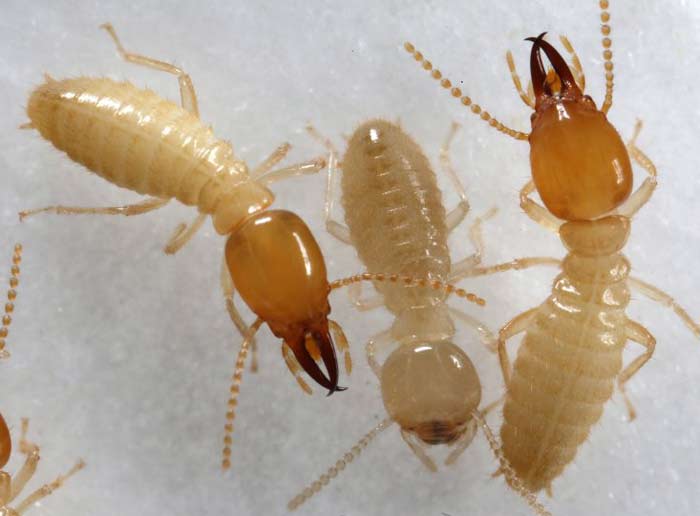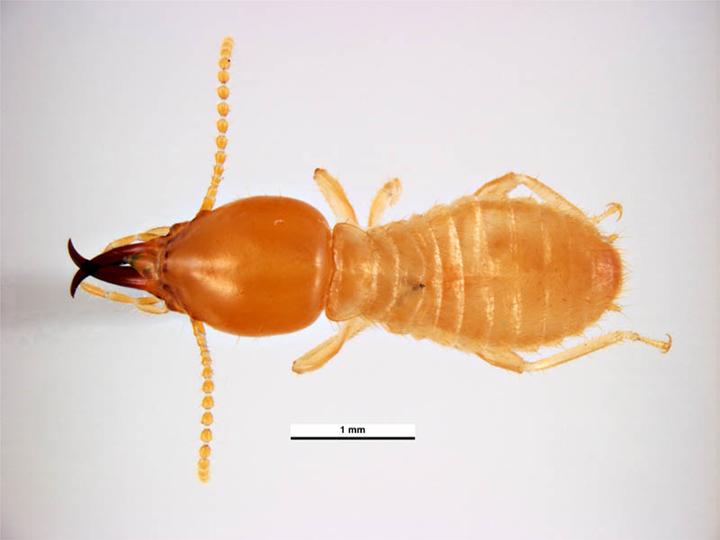Of all the types of termites, formosan are thought to be the most destructive and they spread very quickly. Herein, find how to identify them, appearance in pictures, signs of an infestation, damages, and the treatments you can undertake to mitigate their presence.
Table of Contents
What they’re
These are social insects that are totally different from the others. They are the largest number of pests with about 28 species under them. Their scientific name is Coptotermes formosanus. They are the most widely distributed. Due to their large numbers, they are real potential risks to structures at your home.
These termites are also called super termites because of their ability to chew up wood and increase the size of their colony as compared to the other termite types. The queen termites can live for over 15 years and die having laid up to 2000 eggs each day.
They are also not easy to eradicate once they infest an area and thus a real headache. They exist in three distinct forms:
- The wingless and the winged reproductive alates
- The soldiers that are charged with colony protection
- The worker termites
Identification
Their distinct features make them easily identifiable. To be able to know them from the rest, you can:
- Look at the large numbers in which they exist
- They are yellow to brown in color and a length of about 12 to 15 mm
- They have a number of small hairs on the wings
- The alates are attracted to light and thus found mainly near windows, the window sills, the spider webs and the light fixtures.
- The soldier termites have an orange to brown color and a head that is oval shaped. They have a curved mandible with a white body. The soldiers attack the moment they are disturbed. They also secrete a fluid that is gluey from a large opening in the head.[1]
Pictures
Attached below are some pictures to help you have a clearer view of what the termites look like. This will make it easier for you to identify them.
Infestation Signs
The presence of active termite infestation is manifest by the existence of wings that are shed on the windows, walls and other surfaces. There are other evidences that you can see around the house or structures in the house.
- Swarmers: these are the reproductive termites and you will see around the windows or around the lights in your house. They are majorly attracted to lights at night. When you see them, you should be concerned because they may be attacking the buildings or the structures that are near you. When you see the swarmers in your house, then there is a threat of serious attack and infestation. As they pass the windows, they will drop off their wings around the frames.
- Presence of shelter tubes: they are built from the soil into the foundation of your house. When you break the tubes open, you will notice the presence of a large number of the worker termites and soldier termites.
- Damaged wood: during the initial inspection, this does not come out instantly. They may indicate present or previous infestation. When you tap the wood, you will hear a dull and hollow sound. The damage of wood by these termites is similar to the one caused by the other subterranean termites.
- Presence of nests: they form and build aerial nests that are from chewed wood, the soil, fecal matter and saliva. The nests are big and can be found both in the soil and the ground level. You may not discover the nests unless you remove these coverings. The nests are hard to build and are also found away from structures.[2]
Damage
The damage they cause is similar to subterranean termites but their damage comes more rapidly as compared to the native subterranean termites. They are known to attack more than 47 species of plants which include the citrus, cherry laurel, cedar, sweet gum and the wild sherry. They are also known to eat non cellulose material like the thin sheets of soft metal e.g. copper and lead, plaster as they search for moisture.
Treatment Cost
It may cost you hundreds of dollars to get them out of your home. There are factors which will dictate the cost of the cost which are mainly the method you are using and the area on which the termites are to be removed.
The cost of the treatment is not based on the species of the termite being eliminated. On average, the treatment cost for the elimination of termites can be as much as $ 500 to $ 5000. Other factors that have impact on the cost include the intensity of infestation and the costs of repair for prevention.[3]
How to get rid
You can approach this in two ways. By the use of use of chemical methods or the natural methods. The natural methods include the use of nematodes, cardboards and boric acid. The chemical methods include baiting, fumigation and the treatment of soil.
Nematodes
They are microscopic roundworms that live in a variety of environments. They contain gut bacteria and this makes them very effective pest control organisms. The moment they enter the mouth of the pests, they release bacteria that poison the pest at a very fast rate causing them to die.
What makes the nematodes effective is that they are 100% natural and do not cause any harm to you, your pests or plants. They are effective because they do not stop working after killing the pest.
They instead feed and continuously multiply and hence providing a long term solution. They are long term control measures because after the first week of application, they remain in force till the end. They are also fast killing as they bring about effect within 24 hours of application. They also kill other pests as they kill termites.
The nematodes are considered the most effective natural method of pest control and they die and biodegrade in the soil after killing the termites. When you use them, focus on the garden as this is where the termites originate in most cases.[4]
Cardboards
They are made from cellulose which is the main food that termites feed on. They have a strong smell of wood and this attracts the termites. The smell becomes stronger if you spray some water on it.
If you place the bait in place that is intensely infested, you will notice a lot of termites the next morning and you can hence burn them outside. This a natural, non-toxic and one of the most effective methods. It is therefore able to destroy the entire colony.
Boric acid
This treatment is available as borax. The termites must ingest the boric acid for them to effectively kill them. They do not cause dehydration and they do not absorb their protective surface.
Rather, they cause sterility of the female termites and thus limiting the population growth. Use the boric acid carefully because it can be toxic and can lead to harm. You can use the boric acid for other insects like cockroaches and bed bugs.[5]
Fumigation
This is a method that covers the entire surface with a cover that is like a tent and then release the gas inside. In the destruction of these kinds of termites, it is only effective if it the pests are above the ground. This makes it more effective against the drywood termites.
Soil treatment
This is done at the same time as the wall foam treatment. What you do in this case is distribute the liquid chemical to the soil around the infested structure and then introduce it to the termites. This is able to kill the entire colony exposed, one termite after the other. When these two methods are used together, they are very efficient.
Baiting
It uses the same principle as the cardboard trap. In this case, the cellulose material is soaked in a sow acting toxic chemical substance.
You then place the baits under the ground in cylindrical plastic containers next to the termites’ mud tubes. The worker termites will consume the chemical and then spread and share with other termites finally killing them.[6]
Prevention Measures
In order to ensure effective prevention, you should keep to mind that any wood in your home in contact with the ground is a candidate and thus a threat for infestation by the termites.
Therefore, ensure that you eliminate any chances of wood getting into contact with the ground. This includes the fences, posts and the branches that come into contact with your house.
- Fill up all the holes and cracks in your building that may be passageways for the termites.
- Clear any wood debris that are around the foundation of your house. Always keep it clear. Remove any piece of wood or even the ladder leaning against the house.
- You should seal all the leaking holes in the roof of your house. If your house is raised, check in the under bathrooms and the kitchen for the presence of any leakages.
- Repair any pipes that are leaking. They are likely to create moisture inside the house or even near the foundation. You should make sure the gutters are clean and provide a direct runoff for water from your building.
- Eliminate any piles of dirt near the house after you have treated the soil.
Further Reading
- Termite Barriers (Shields): Types, Cost, how they Work & Products
- Termites Damage, Pictures, Repair Cost, Ceiling, Floors, Wood & Fix
- Best Termite Sprays-Orange Oil (DIY), Boric Acid & Spectracide Reviews
- Termites Life Cycle & Span-Eggs, Larvae, Baby & Adults
- How to Prevent Termites-Tips to Protect your Home
- Signs of Termites Infestation-How do you know if have you them?
- What do Termites look like? Pictures, Size, Color & Look-alikes
- Termites: Where From, Habitat, Eat, Noise, Types +more!
- Subterranean Termites Swarmers Treatment Cost, Damages & Pictures
- Flying Termites with Wings (Swarmers) Pictures & How to get Rid
- Termite Droppings-Drywood, what they look like, Health Risks, Clean vs Sawdust
- Formosan Termites Pictures, Signs Treatment & Damage
- How to Get Rid, Kill Termites + Treatment Cost
- What Causes & Attracts Termites?
- Do Termites Bite Humans? Pictures & Remedies
- Flying Ants vs Termites-Differences & Similarities
- Termite Inspection Cost, Procedure, how long it takes & Training
- Termite Colony-Queen, Soldier, Worker & King
- Drywood Termites Treatment Cost, Get rid & Damage
- Termite Bond Cost, Benefits
- Termite Baits, Stations & DIY Traps
- Dampwood termites Pictures, Damage & Treatment
- Termite Tenting & Fumigation- Cost, Preparation, Safety & Cleaning After
References
[1] http://entnemdept.ufl.edu/creatures/urban/termites/formosan_termite.htm
[2] https://urbanentomology.tamu.edu/urban-pests/termites/formosan/
[3] http://costculator.com/termite-treatment-cost/
[4] http://pestkilled.com/nematodes-for-termites/
[5] https://www.dodsonbros.com/borax-boric-acid-insect-control/
[6] http://pests.guru/termites/types/formosan/control.html

